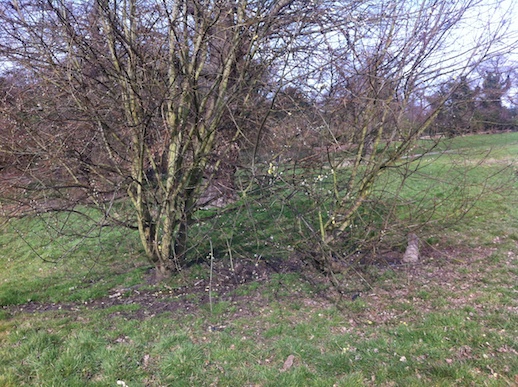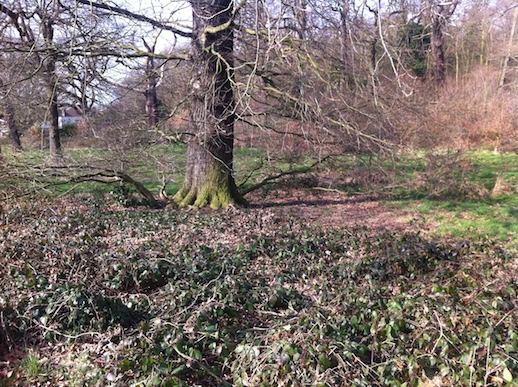By Emma Warren.
Oxleas Woods are a natural boundary. They mark the edges of Greenwich and Bexley boroughs, and they’re a transition point between the final stretch of London and the early pushes of Kent and country. Go up the hill and you’re leaving London. Go down the other side, towards Welling, and you’ve left.
It’s the café, named The Best Kept Secret, which is my personal boundary between woods and not-woods. Today I’m standing outside, looking down onto Oxleas Meadow. Jack Wood is to the right, or the West if we’re speaking directionally. London is behind me.
Before the wood starts proper, there’s a patchy stand of trees and saplings marooned away from the main bulk of the woods by way of a broad path. I stroll down to the top corner. There’s a fat shrubby Goat Willow. The buds are soft and downy, heads tipped towards summer. Most of the buds have half burst into yellow pointillist tips, shedding furry down like foam.
Down to my right, an oak, the oldest guy on the patch. There’s a small hole at the bottom of the tree which might be big enough to crawl into in a hundred years hence. The buds are still clamped shut. Just down a bit there’s a cluster of young oaks heading for big things. They’re so short and stubbly, displaying the beginnings of their oaky bark markings. They look squat and powerful.
Next up, a bramble patch and four lightening white dead trees with broken arms. An empty acorn cup. A crow chasing a parakeet up above. A dollop of dock leaves punctuated by a discarded black poo bag. Shrubby buds opening up pinkish like flamingos. Another bramble patch.
Surveying the surrounds, it’s clear that some of the trees have been more successful than others. Some oak have tens of sapling children at their feet, others hardly any. Is this how trees move, sapling by sapling, century by century?
Back to the café, past a powerful horse chestnut with fat fingers and fat sticky buds. The Artful Dodger mix of Tina Moore’s Never Let You Go is on the radio. It’s a reassuring bridge back into the other world, along with a cup of tea and marmalade on fat white toast.
There’s a photograph taken in the 1950s on the café pinboard, of the stand of trees I’ve just walked around. It’s taken from the path that runs from the café to Jack Wood and it’s strikingly similar to what I can see now, six decades later. The penny drops on how slowly these things move and how speedy human lives are by comparison. The trees are on Venus time, taking a couple of hundred days to make one rotation whilst we’re spinning speedily, daily.
I hang around for a ramble organised by Greenwich Park Rangers who do a brilliant job of maintaining the woods and making it accessible to local people. On the margins, Oxleas is very human wood. Patches of daffodils are framed by two blue cans of Tenants, chucked on the floor but positioned in a can-shaped embrace, lids touching. There’s a broken pallet in a bramble hedge. I see a can of Nutrament on the floor as we exit the woods through a bush that takes us onto Kidbrooke Common. There is tree graffiti.
Later, I’m here with my friend Sarah and her black and grey spaniel, Skipper. Sarah’s a bit cautious about coming today because she’s heard people have been putting down rat poison. She’s an exceptionally rational individual so we come anyway but we both keep an eye on the dog, and we both notice that most of the other dog walkers have their hounds on leads, which is unusual. I suspect there’s been a mass spooking of the local dog people, of whom there are many. Usually the woods are sparking with dogs fighting, dogs sniffing, dogs just hanging out at a massive daytime doggy rave. To be honest, Skipper seems more interested in the tiny, intermittent waterways and muddy puddles than he does seeking out poison. By the end he is more mud than fur.
We go on a search for Severndroog Castle. I know roughly where it is and we head in that direction, keeping mostly to the paths. The concrete path changes step by step into worn mud and gravel, and even though I’m looking for it there’s no obviously transition point. The path doesn’t appear to end anywhere, it just changes. We weave up and down, past a yew which is growing and leaning into the incline, making a tunnel. There’s a remnant of Wood Lodge, the country home that was demolished in the 1930s. And on the right, a steep incline still littered with brown autumn leaves. We could walk around the path to the castle but no, two grown women and a dog scramble up the hill, inelegantly pulling ourselves up the last stretch on roots and weeds.
The renovated castle looms. It looks so elegant. Down at ground level, though, someone’s already sullied the fresh cream paint with crap graf. Plus ça change!

